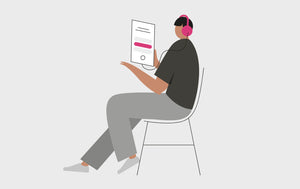Guide To Hearing
Hearing is a precious gift which helps us make sense of the world around us. Scientists tell us that our ears pick up air waves and translate them into sounds in our brain but hearing is so much more than that; chatting with friends, listening to our children, talking through problems or relaxing to music. Sounds provide information and evoke thoughts and feelings that give meaning to our lives.
This guide to hearing covers the following:
What is sound?
How do we hear?
What can go Wrong?What does a hearing assessment involve?What happens during a hearing test?
What do the results of an audiogram mean?
What does it mean to have hearing loss?
An introduction to hearing aids
What is Tinnitus?
What is Sound?
Put simply, “Sound” is waves or vibrations of air. A healthy ear is able to pick up vibrations that are measured in a basic unit of frequency known as Hertz or Hz. The ear converts vibrations into electrical signals sent to the brain, where they are translated into meaningful information such as speech and music.
Our brain works out what type of sound it is according to the volume and the pitch of the vibrations. The volume of sound is measured in decibels. The greater the volume the further the sound travels and the louder it sounds.
The rate at which a sound vibrates is called its frequency and the higher the frequency the higher-pitched the sound, such as a flute or birdsong. An example of a lower-pitched sounds could be the rumble of distant thunder. Frequency is physical measurement and pitch is a measure of how we
perceive frequency.
Loudness varies from person to person, how we describe a sound as being inaudible, very soft, soft, moderate, loud, very loud or too loud. For the same volume of sound, people might rate them differently. For example, one might rate rock music as loud and another might rate it as too loud.
The characteristics of different sounds vary widely. Simple sounds such as pure tones contain only one frequency. However, most everyday sounds are complex sounds consisting of many frequencies.
Speech, for example, consists of vibrations at different volumes and numerous frequencies and most are between 250 and 8000Hz.
How do we hear?
Sound travels in waves of pressure through water, gases (like air) and other matter. It is the means of auditory communication but how do we make sense of what we hear? The human ear is designed to be a receiver of sounds but also plays a major role in balance and body position.
Our ears are divided into three parts – the outer ear, the middle ear and the inner ear. Sound waves travel through each part of the ear to the brain where they are analysed and interpreted into meaning.
The best way to describe how our ears work is to describe the pathway sound takes through each part:
1. The outer ear
The outer ear includes the pinna, the ear canal and the eardrum (tympanic membrane). The pinna is the external part of the ear made of cartilage, tissue and skin. It collects and directs sounds into the ear canal and protects the ear canal. The ear canal is a tube that directs sounds onto the eardrum.
2. The middle ear
The middle ear is an air-filled chamber connected to the nasal and throat passages by the Eustachian tube which equalises air pressure on both sides of the ear drum. Usually closed, the Eustachian tube opens naturally when you swallow or yawn.
Sound reaching the eardrum causes it to vibrate, transmitting that sound to the three smallest bones in the body. These bones or ‘ossicles’ are commonly referred to as the hammer (Malleus), the anvil (Incus) and the stirrup (Stapes) that connect the eardrum to the inner ear. These tiny ossicles amplify the vibrations and direct the waves of sound into the inner ear.
3. The inner ear
The inner ear is filled with a fluid and consists of the spiral shaped Cochlea, named from the ancient word for the shell of a snail. The passageways of the cochlea are lined with over 15,000 microscopic haircells (referred to as inner and outer hair cells) that convert sound vibrations into nerve pulses
which are then sent to the brain.
The auditory nerve contains thousands of nerve fibres that help our
brains interpret these pulses into meaning. The inner ear also contains our ‘vestibular system’ in the form of the ‘semi-circular canals’, and is important in maintaining balance and body position.
What can go Wrong?
Types and causes of hearing loss
Whilst there are many reasons for hearing loss, the condition itself falls into two main categories - Conductive and Sensorineural. Hearing loss can also be attributed to a combination of both types – a mixed hearing loss.
Conductive hearing loss is caused by any obstruction that prevents sound waves from reaching the inner ear. Some of the causes of conductive hearing loss can include:
- An accumulation of earwax
- A collection of fluid in the middle ear (for example, “glue ear” in children)
- Abnormal bone growth in the middle ear (otosclerosis)
- Middle ear infections (otitis media)
- Perforation of the eardrum
Sensorineural hearing loss refers to problems in the cochlea or the auditory nerve. Deterioration of the tiny inner or outer hair cells in the cochlea is the cause of most permanent hearing losses and although it may be a natural part of aging other causes can include:
- Prolonged exposure to high noise levels
- Head injury
- Viral infections of the inner ear and/or auditory nerve such as Mumps
- Certain medical treatments such as chemo- and radiation therapy
- Genetic predisposition
It is possible for a conductive hearing loss to occur together with a sensorineural hearing loss. When this occurs, the hearing loss is referred to as a mixed hearing loss.
What does a hearing assessment involve?
Hearing tests are quick and relatively simple for the person being tested. Results are instant, and you will know immediately if you do have a hearing problem and what steps to take. To many the results of a test, whatever they are, come as a huge relief. Once they have sought that initial help they find
the subsequent process straightforward and altogether life changing.
Your hearing healthcare professional will usually begin by asking you questions about the health of your ears and general health and your lifestyle. By asking these questions they can determine the possible damage that may have been caused to your ears from such things as illness, age, your job, your hobbies etc.
Ear examination
A physical examination of your ears is performed to eliminate problems such as infections or blockages such as wax. Otoscopy is an examination that involves looking into the ear canal and at the ear drum with an otoscope. Inspection of the eardrum can also provide information about what is happening within the middle ear.
What happens during a hearing test?
Amongst all the tests that can be performed on your hearing, pure tone audiometry is the most common. This evaluates the sensitivity of your sense of hearing at different frequencies.
A set of headphones is worn over the ears or foam earphones placed in the ear canal; and you may be required to sit in a sound-proof test room. The headphones are then connected to the audiometer.
This piece of specialised equipment produces tones at specific frequencies and levels to each ear independently. The patient will communicate that they have heard the tone by either raising their hand or pressing a button. As the test progresses, the hearing professional will plot your ‘thresholds’ on a graph called an audiogram.
A threshold is the softest volume you respond to a tone. Once each
frequency has been tested and plotted, the points are joined by a line and the hearing healthcare professional will help explain how your results compare to what is considered to be normal hearing.
What does it mean to have a hearing loss?
The impact on our lives and those around us from hearing loss can be far-reaching. It becomes harder to distinguish between speech and noise. You can feel lonely or frustrated. You may fall behind at work, limit your social life, and just ‘miss out’. But you are not alone - although aging causes our ears to deteriorate, 20% of all 40 to 60 year olds also have some form of hearing loss.However, a lack of knowledge and social stigma prevent many from being helped by simple, effective solutions.
How people classify themselves relative to hearing loss is a very personal decision and reflects much more than just their ability to hear. It can be difficult too because hearing loss is often not constant.
Hearing impaired people with partial loss of hearing may find that the quality of their hearing varies from day to day, or from one situation to another or not at all.
There are many effects of untreated hearing losses which can get worse over time. Many feel anxiety or a lack of confidence. This could cause depression or cause people to withdraw from social situations.
The good news is that if you are worried about a hearing loss, there is help available.
Quick Checklist
You may have a hearing loss if you have ever had:- Noise exposure (at work or at play)
- Viral ear infection
- Chemo or radiation therapy
- Or hearing loss in your family
- Struggle to use the phone
- Think that people mumble
- Have to turn up the TV volume much louder than other family members
- Have difficulty following conversations


